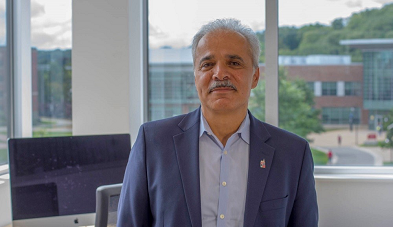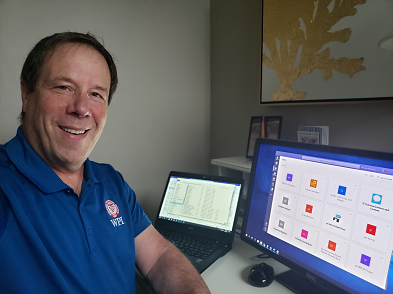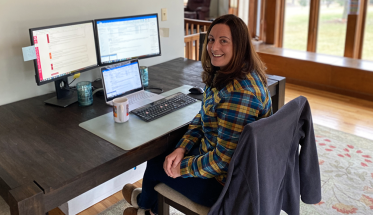As faculty, staff, and students rushed to prepare for teaching, working, and learning online at the outset of D-Term due to the pandemic, behind the scenes the university’s IT staff was working around the clock to set up the technology that would make it all happen.
With the coronavirus pandemic buffeting the country last month, WPI, keeping the safety of students, faculty and staff top of mind, worked to close the campus. That meant classes needed to be taught online and faculty and staff needed to work from home. IT leaders and technicians worked relentlessly and had to think creatively to prepare the university. And they had a very hard deadline to hit.
“Normally it would take months if not more than a year to do what everyone accomplished in a matter of a few weeks,” says Patty Patria, vice president for IT and chief information officer. “We have a wonderful, talented staff in IT. There were teams that certainly were working nights and weekends. We had people willing to think outside the box to figure out how we could deploy so many services and get the university successfully up and running for the first day of classes. That, at the end of the day, was our goal. People had to be able to work remotely and teach remotely—and students had to have what they needed to learn remotely.”
The day after Massachusetts declared a state of emergency—and the very day the World Health Organization (WHO) officially classified the coronavirus outbreak a pandemic—WPI announced that the beginning of D-Term would be pushed back and all classes would be moved online. Two days later, the university encouraged employees who could work from home to do so and then went even further, announcing the following week that the campus would be closed in a matter of days to everyone except those with an emergency designation.
The situation was changing rapidly. And that meant the demands on WPI’s network and systems were changing just as quickly.
The school’s Information Technology Services staff of about 90 had to make a hard shift to move about 7,000 students and 1,500 faculty and staff to a whole new way of learning, teaching, and working.
That abrupt and dramatic shift simply couldn’t have happened without IT Services.
Patria passionately talked about the Herculean efforts that her entire IT staff put in to prepare WPI to successfully educate students during a pandemic. Here's a look at three of those people, and the work they and their teams put in to enable WPI to work remotely.
Taking Care of Academics and Research Computing

Sia Najafi, executive director of academic and research computing, has been connected to WPI since he entered as a freshman mechanical engineering major back in 1978. He later returned to earn his master’s degree, also in mechanical engineering, in 1990. He’s been on WPI’s staff coming up on 35 years. WPI simply got into Najafi’s blood. “I’m looking out my office window and I can see my dorm room from 1978,” he says. “It’s been years and I’ve moved about 100 yards.”
That connection meant he was going to do everything in his power to make sure students would keep learning and research would continue—all off campus—when D-Term started.
“We had two or three weeks to get ready for D-Term to be held online,” says Najafi, noting that all five of his team members have PhDs. “We had to start scrambling. It would normally take us a year or two to accomplish everything we did in those few weeks—to implement and test, to work out the bugs, and scale up from there. We had to squeeze it into a couple of weeks and then hold our breath and hope it held up. There was nothing we came across that we couldn’t solve.”
So, what did Najafi and his team get done in those couple of weeks?
- They expanded the WPI cloud system by taking some of the high-performance computer clusters and converting them to support the cloud so students would get a better experience working remotely.
- They adopted a new Microsoft cloud environment and used it to create virtual desktops to meet the expanded need for remote students who needed to run heavily graphic applications.
- They created virtual computer labs in WPI’s own cloud system.
- They negotiated with software vendors to get their approval for students to install their software directly on their own computers, instead of running only on WPI machines.
“We have a deep knowledge of how WPI academics operate and we planned pretty well for whatever contingencies we thought we might face,” he says, adding that his whole team worked 17-hour days for weeks. “Everything that needed to happen had a huge underlying IT reliance. That showed in the first week of classes going pretty smoothly. Our preparation was on target.”
Najafi even gave his personal phone number to the department heads, the provost, and the deans. From 7 a.m. until he fell asleep late at night, he was on call. “We understood the urgency,” he says. “I would put our IT team against anybody’s. Working together, we pulled it off.”
Getting 300 Faculty Teaching 700 Courses Online in D-Term
Kate Beverage, director of technology for teaching and learning services, says her team’s biggest challenge was helping faculty figure out—in about 10 days—how they could best teach their classes online.
“It was about being able to help faculty think outside the box for how they would do their most challenging activities,” says Beverage, who has a team of seven. “How do they do labs online? How do they facilitate project-based learning? How do they help their students work together when they’re dispersed around the globe? How do they make sure their students feel supported? This term is totally different than a regular class. My team partners with faculty and WPI offices to make sure they can connect with students.”

Beverage’s team took on the following:
- Launching multiple online teaching training sessions that faculty could attend in person or virtually.
- Training and supporting 80% of the 300 faculty members teaching in D-Term on how to best teach online. A quarter of the faculty received one-on-one training, and the rest opted for group training.
- Creating an “Online Courses in a Hurry” resource, pulling together related articles, tutorials, tips, and best practices about using videoconferencing and other online education tools.
- Lending 90 to 100 laptops to faculty members and staff.
- Helping faculty reimagine their classes and figure out what tools and capabilities they would need—like videoconferencing, recording lectures, and holding virtual field trips.
“There was a lot to getting all of this ready that IT organized,” says Beverage, who has worked at WPI for almost 15 years. “In the first three days of D-Term, we had 2,600 Zoom sessions. That was 1.1 million minutes on Zoom. And professors had already recorded 615 new videos for their classes. It was huge. So much was happening behind the scenes. It was making the magic happen.”
What made a big difference was that Beverage had an experienced team, which included instructional designers and instructional technologists, and WPI already had a solid infrastructure in place. Plus, some professors already had been using video to supplement their normal classroom work.
“My entire team deserves a ton of credit,” says Beverage. “Everyone was responding to emails 24/7, ordering cameras, scrambling to loan out equipment, and thinking about what faculty might need before they actually needed it. It was a big lift. When we heard we needed to do this, no one panicked. We just said, ‘OK, what’s next?’ I never thought we couldn’t do it.”
Turning Long-Term Plans Around in Weeks

Mark Taricco, executive director of IT infrastructure and operations, says he didn’t really have any fears when he heard his team had to change the way everyone teaches, learns, and
works at WPI. Seriously … he didn’t.
“This group was incredible. They just dove right in and started putting things in play,” he says of his 36-member team. “I’ve had enough time with them to know that this group has the capability of flipping things fast and doing it right. We would have wanted to have a little more time to plan, but when we gave the team the go, they just went and got it done.”
Taricco says the first thing he did when he learned classes would be going online was to check in with his networking team. He had to understand what kind of network performance they could expect, how much the network needed to be built out, and how students could best remotely access their files. Once he confirmed that WPI’s Internet connections were solid, he turned his attention to other projects …
- In two days, the team doubled the number of terminal servers, which allows students, faculty, and staff to leverage software normally available in physical labs and files normally only accessible from the WPI network.
- It increased Pulse VPN capacity from 200 to 500 concurrent licenses to allow all employees to work remotely, and deployed new Palo Alto VPN to students and IT staff to allow for additional capacity.
- In a day, the Support Services group and ITSM team reconfigured the way student registration questions are handled. Instead of student emails going into an inbox, now each student question or request is automatically turned into a ticket to speed the request through the system.
- The hardware team, which normally distributes and handles problems with computer systems on campus, had to rethink how it would remotely help people with laptop trouble. Team members worked out a system to procure, configure, and ship new systems to WPI faculty and staff overnight.
- All students were moved to One Drive, decreasing the need for them to have VPN connections for sharing files.
- "Soft phones" were deployed to allow critical offices to answer campus phones from their computers at home.
“Some of these were things we’ve been wanting to do for a long time,” says Taricco. “Within two weeks, we did work that a vendor would have charged us $10,000 for each individual project—and taken three to six months to do. We brought it all online in a couple of weeks. I’m very, very proud of everyone on the team, no matter what roles they played. This scenario has proven why this is the best place I’ve ever worked.”



